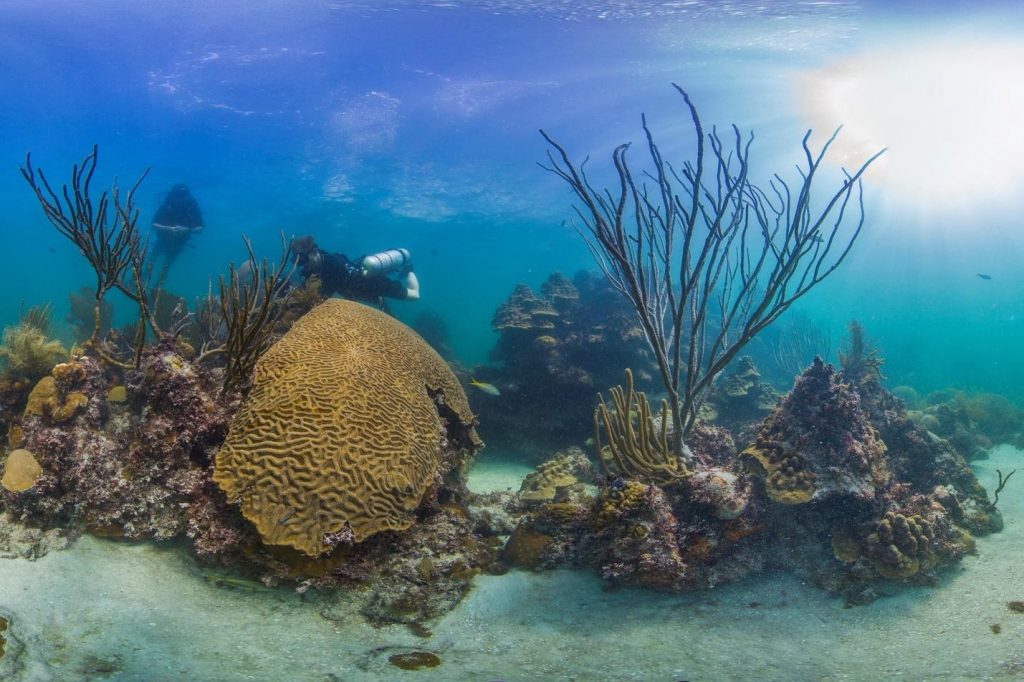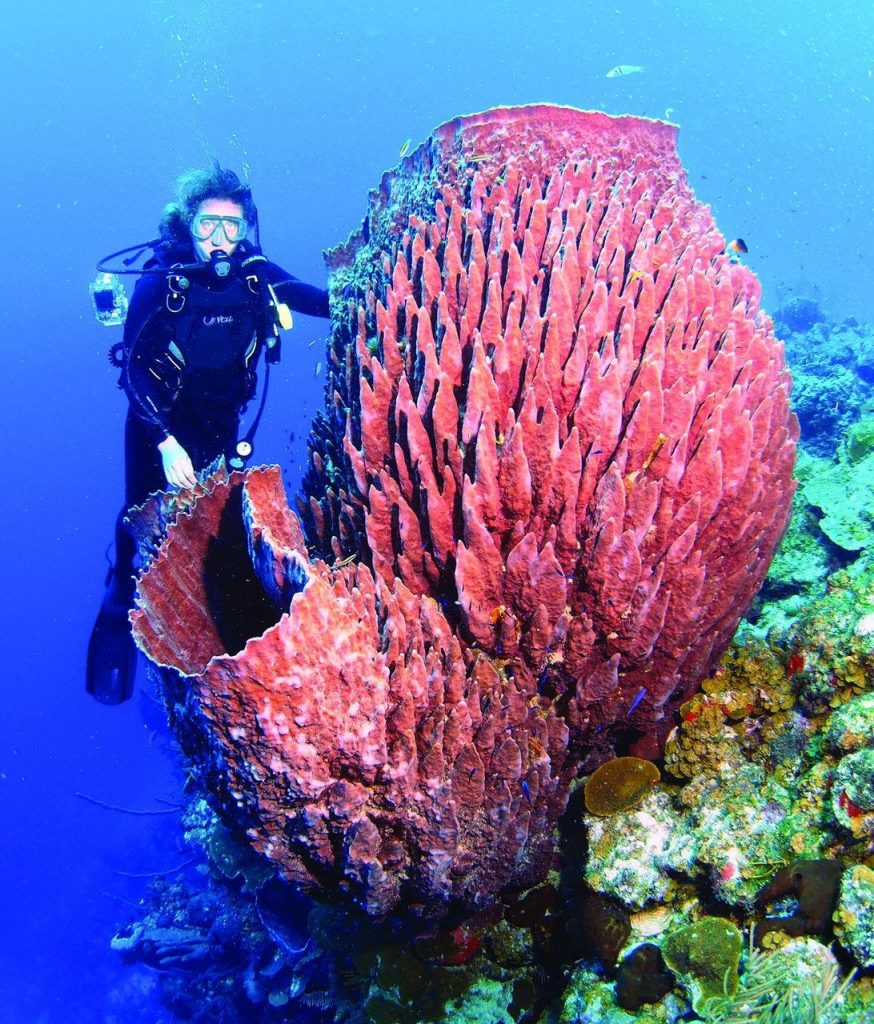The Caribbean Sea reef system has a complex geological and oceanographic history, with various occurring events of extinction and speciation. Continuous movement of tectonic plates resulted in numerous recurring seismic events, including earthquakes, tsunamis and volcanic eruptions. New islands formed and communication with the Pacific Ocean was cut with the rise of the Panama Isthmus some 10 million years ago. These seismic events left the Caribbean with far fewer species of reef-building corals and fish than in other regions of the tropics (1).
It was a time for remodeling the shape and tone of life in the newly formed Caribbean Sea.
The seascape is distinct in that it sits in a fairly enclosed body of water bordered by continental landmasses that contribute a substantial freshwater input from major river systems, including the Hondo, Orinoco, San Juan and Magdalena. There are several kinds of interactions on the Caribbean like the seasonal depositing of Sahara desert dust carried by transatlantic winds -a unique phenomena to the region-, churning of the surface currents known as the “mixing bowl” effect, and even effects from the Amazon River during half of the year as a consequence of wind patterns (2).

Descendants of Asian migrations, more than 10,000 years ago, were the first to colonize Caribbean shores, exploiting resources so much that, for some groups, it was their main dietary source. Their impact is observed in the decrease in the mean individual size of some fish populations and, also, in leftover queen conch shells (Strombus gigas) (1). Today, it is important to recognize the value of the knowledge and innovation of these people, historically associated with the shorelines and coral reefs, whose practices are more relevant than ever for conservation and the sustainable use of Caribbean Sea biodiversity (3).
Although coral reefs only cover less than 0.1 % of ocean floors, they are considered the ‘forests of the sea’ supporting 25% of all marine species, providing them shelter and nourishment, be it for a shot time as juveniles, or for whole life cycles. While corals are the architects of the reef’s beautiful and complex structures they are not the only builders, others include coralline algae that cements corals together and tube worms and mollusks that provide their hard skeletons. Principal reef builders in the Caribbean Sea, include several species of the coral genus Acropora (branching corals) and Orbicella (encrusting, boulder corals). Today there are 70 known species of coral in the region, a number that is constantly revised by new molecular and high-definition morphological techniques (1).

Of these coral species, stony reef builder are the ones that construct the backbone of the ecosystem. Each of these corals structures consists of thousands of colonies of cuplike calcium carbonate corrallites made by tiny animals called coral “polyps”. Each coral polyp resides within an individual protective corallite that helps form what is known as the skeleton. A polyp has a mouth opening surrounded by stinging tentacles called nematocysts, which extend out at night to capture food. These tentacles contain stinging nematocysts, organelles that deliver venom to catch small prey. Most shallow water tropical coral polyps have translucent bodies but gain pigmentation via a symbiotic relationship with dinoflagellates algae (of the Symbiodiniaceae family), which resides in the coral tissue. It is estimated that in this complex interdependence this algae genus provides 90% of the energy requirements of the coral host and also facilitates the calcification of the exoskeleton (4). In return, the coral protects the algae and uses it to recycle waste carbon and nitrogen. Other microorganisms inhabiting corals include bacteria, archaea, fungi, protozoa, pathogens and viruses (5).

Caribbean reefs are important because they provide ecosystem services to many millions of people; the social, cultural and economic value is estimated at US$ 1 trillion. In addition, fringing and barrier reefs play a major role in protecting shorelines and stabilizing beaches, minimizing damage to human infrastructure as hurricane intensity increases with the rise of average global temperatures.
But the joint effects of hurricanes, diseases, specie introductions and human activities have decreased the overall performance of the Caribbean reef ecosystem in an unprecedented manner. Evidence over the last 30-50 years suggests severe stress and deterioration of the environment, which is under assault from numerous factors mentioned above and that vary locally (6). Estimates are that between 50-80% of the Caribbean corals disappeared in that time frame. According to the status and trends of Caribbean coral reefs, coral coverage on the most recent data for all the locations is 16.8% (with a range of 2.8-53.1% varying significantly between locations). The Intergovernmental panel on climate change (IPCC) reports that human activities are the cause of detrimental factors such as surface ocean warming, acidification, eutrophication, pollution and overexploitation.
A recent study, claims that Caribbean reefs are changing rapidly into new, never-before-seen ecosystems. New to these reef ecosystems is the power struggle between sponges, soft sea-fans or tubular gorgonians and seaweed cover, which are now occupying space over the diseased coral and are, overall, more successful under the altered chemical and nutrient composition conditions of the ocean. Sponges in the Caribbean are abundant and now cover about as much reef area as reef building corals (7). Among these are the giant and beautiful barrel sponge (Xestopongia mutua) which can live for centuries. This alteration in the ecosystem, negatively impacts the coral microbiome making it more difficult for corals to survive.

Fortunately, coral degradation has been avoided in important parts of the Caribbean, with some reef environments continuing to provide clear waters that are home to many of the mixed coral zone species, extending below 50m and well into the mesophotic zone (100m). It has been suggested that, depending on the type of symbiont algae inside their tissue, corals may acclimatize to deeper depths, creating a “safe zone” for major reef building corals, a possible key to their survival (8). The proposed Seaflower Biosphere Reserve will extend from the Caribbean coast of Honduras down to Colombia and include the coastal waters of Nicaragua, Costa Rica, Panama and Jamaica. It will play a vital role in protecting, maintaining and improving populations of rare or endangered species, sustaining genetic diversity, ecosystem function and the viability of nursery and breeding grounds.

References:
(1) Reyes-Bonilla H.; Jordán-Dahlgren E. (2017) Caribbean Coral Reefs: Past, Present, and Insights into the Future. In: Rossi S., Bramanti L., Gori A., Orejas C. (eds) Marine Animal Forests. Springer, ChamSanchez, JA; Gonzalez-Zapata, LF; Duenas ,LF; Andrade, A; Pico-Vargas, AL; Vergara ,DC; Sarmiento, A; Bolanos, N. (2019). Corals in the mesophotic zone (40–115 m) at the barrier reef complex from San Andres Island (Southwestern Caribbean), Frontiers in Marine Science. 6: 536–542.
(2) Pawlik,J; Burkepile,E; Vega,R. (2016). A Vicious Circle? Altered Carbon and Nutrient Cycling May Explain the Low Resilience of Caribbean Coral Reefs, BioScience 66:6:470–476,
(3) Prideaux, B, Pabel, A. (2018). Coral reefs: Tourism, conservation and management. Routledge.
(4) Jeong, HJ; Yoo, YD; Kang, NS; Lim, AS; Seong, KA; Lee, SY; Lee, MJ; Lee, KH; Kim, HS; Shin, W; Nam, SW; Yih, W y Lee, K. (2012). Heterotrophic feeding as a newly identified survival strategy of the dinoflagellate Symbiodinium. Proceedings of the National Academy of Sciences. 109:12604–12609.
(5) Bourne, DG; Morrow, KM y Webster, NS. (2016). Insights into the microbiome: underpinning the health and resilience of reef ecosystems. Annual Revision of Microbiology. 70:317–340.
(6) Hughes, T; Barnes, M; Bellwood, D. et al. Coral reefs in the Anthropocene. Nature 546, 82–90 (2017).
(7) Loh, TL; McMurray , SE; Henkel, TP; Vicente, J; Pawlik, JR. (2015). Indirect effects of overfishing on Caribbean reefs: Sponges overgrow reef-building corals. PeerJ 3, e901
(8) Sanchez, JA; Gonzalez-Zapata, LF; Duenas ,LF; Andrade, A; Pico-Vargas, AL; Vergara ,DC; Sarmiento, A; Bolanos, N. (2019). Corals in the mesophotic zone (40–115 m) at the barrier reef complex from San Andres Island (Southwestern Caribbean), Frontiers in Marine Science. 6: 536–542.


